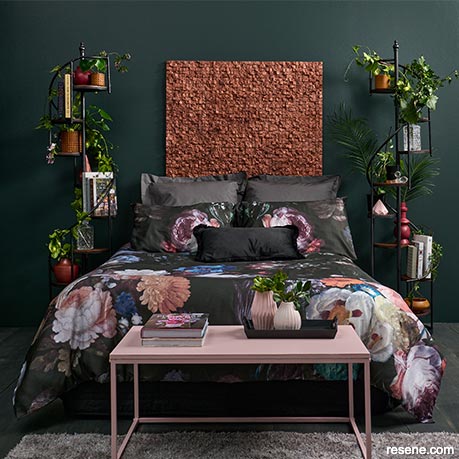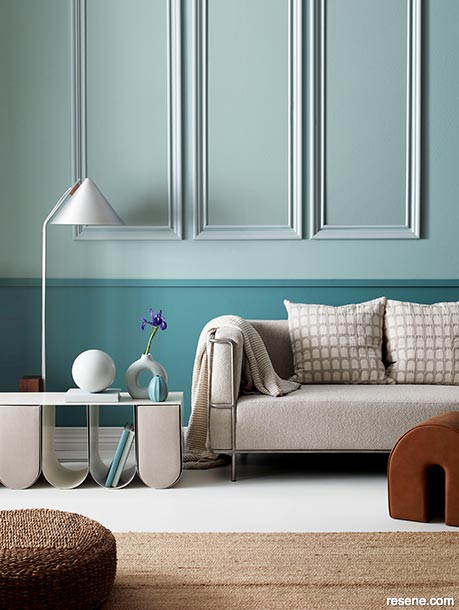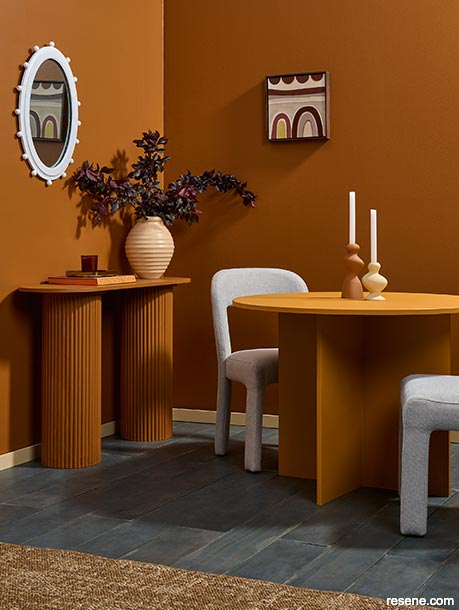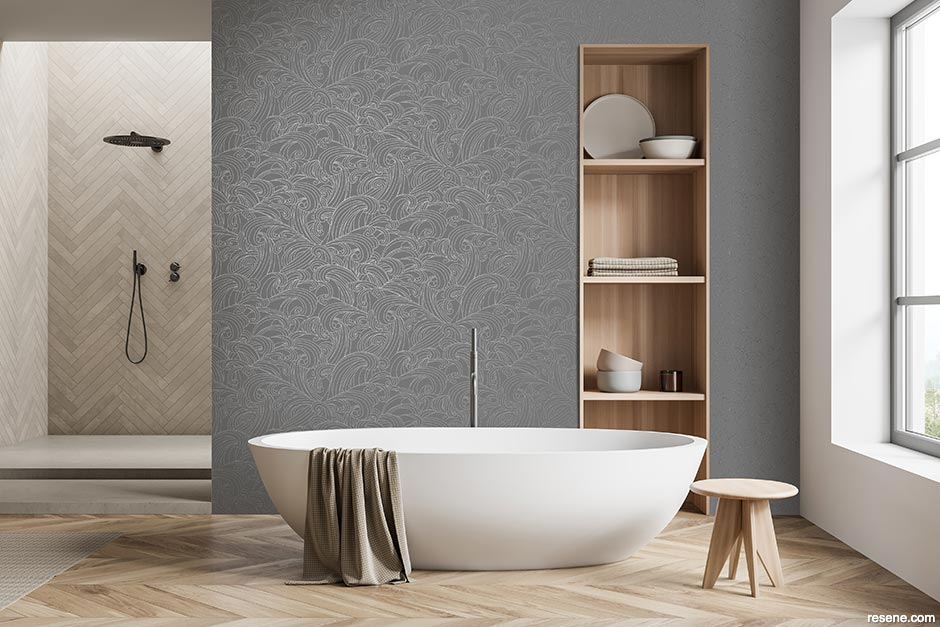From the Resene decorating blog
Here are some handy tips and tricks from Resene Paint Expert Jay Sharples.

Calculating how much paint you need is an important part of planning a project and sticking to your budget. Try the online Resene Paint Calculator for a guide.
Wall painted in Resene Forty-Six with floor finished in Resene Colorwood Shade, table in Resene Valentine, bedside bookshelves in Resene Triple Foundry, DIY artwork in Resene Copper Fire, vases on bookshelves in Resene Valentine, Resene Inspire, Resene Cape Palliser, Resene Korma, Resene Pendragon and Resene Vanquish and vases on table in Resene Inspire and Resene Valentine with tray in Resene Triple Foundry. Resene Living duvet from Briscoes. Project by Megan Harrison-Turner, image by Bryce Carleton.
Redecorating your room yourself can be a great way to get the look you want in a timely and cost-effective way – but there are always more tips and tricks to learn to help you get the best result possible, and to help make sure you’re getting the most from your renovation budget.
Talking to experts at your local Resene ColorShop is always a great way to solve problems or find answers to technical questions, but to get you started here are some handy tips and tricks from Resene Paint Expert Jay Sharples:
Jay says: “The drying times are all written on the back of the Resene paint can or pail. These are worked out based on working at temperatures of approximately 18 degrees Celsius and at 70% humidity. Changes in the temperature and humidity can affect your drying times or stop the paint drying altogether. Cooler weather and higher humidities will slow down the drying. Hotter weather and low humidities will help to speed it up.
“You do need to think about the temperature, humidity and airflow when it comes to painting and while the paint is drying. Think about the time of day you are starting and the time you will be finishing. A good way to think about it or judge it is: would my clothes dry on the washing line? If the answer is no, then your paint won’t dry either.”
Top tip: Resene Wintergrade Additive allows paint to be applied down to 3 degrees Celsius. You also need to be wary of painting on very warm days as the paint can dry too quickly, causing it to thicken and creating brush streaks. Try adding Resene Hot Weather Additive to your Resene waterborne paint to slow the drying if you finding you need a little more time to get a smooth finish in warmer weather.
Jay says: “The spreading rate of paint is all about how much product you need to cover your surface adequately for a quality finish. It’s also important in making sure you don’t buy too much or too little paint.

Taking your time and using the right brushes makes cutting in around details such as these wall mouldings key to a polished finish.
Lower walls and dado rail painted in Resene Undercover, upper walls in Resene Ashanti with mouldings in Resene Hermitage, floor and skirting in Resene Half Sea Fog, vases and books in Resene Ashanti and Resene Undercover and ball sculpture in Resene Hermitage. Throw from Niche, ottoman from Indie Home Collective, cushion fabrics from Atelier Textiles, sofa, lamp from Maytime. Project by Tracey Strange, image by Belinda Merrie.

Using a roller can be a fast, effective way to get a smooth result on walls. Rougher or textured surfaces may need a brush to ensure good coverage.
These walls and console table are painted in Resene Cinnamon with floor finished in Resene Colorwood Shade and skirting in Resene Calico. Table in Resene Mai Tai, mirror frame in Resene Alabaster, large vase in Resene Manhattan and candleholders in Resene Cinnamon and Resene Calico. Artwork by Stephanie Parkes. Project by Melle Van Sambeek, image by Bryce Carleton.
“Put too little paint on and you'll waste time and money having to put on an extra coat just to get on the paint that should have been applied in previous coats. Get it right and you can get the optimum finish in the prescribed number of coats.
“The theoretical spreading rate for each product is printed on the back of the Resene can or pail. Typically, one litre covers approximately 10 sqm. So if your area is 3m x 3m you will use nearly one litre of paint per coat. If it appears as though you’re going to have lots of paint left over, it could be that you aren’t applying enough product.”
Top tip: Spreading rates may differ between paints based on how thick or thin the product is.
Jay says: “It depends on the finish you’re after. Generally, you use a brush to ‘cut in’ around the edges in a room, the joinery or the fittings, then roll out the larger areas of wall or ceiling.
“Some people prefer a brush finish on some surfaces and others prefer a roller. The surface you are painting can impact the method of application. For example, rough-sawn timber will take longer to brush but you will be able to work the paint into all the peaks and troughs and coat all the surfaces, whereas rolling you might not manage to coat everywhere.”
Top tip: It takes time to become good, accurate and fast with a paintbrush. Have patience with yourself if you’re just starting out. Work on your quality first, then on speed. This way you will speed up your quality work rather than start and speed up sloppy work.
Jay says: “It depends on the job and the person using the brush. The brush will get heavier when filled with paint and as the day or job goes on.”

Things to consider when a selecting a paintbrush:
Using a large, heavy brush for extended periods will be tiring, so you may wish to select, or start with, a smaller brush.
Oval brushes are good general purpose brushes, flat brushes hold more paint but are less accurate, specialist cutting-in brushes are ideal for cutting-in and fine finishing but do not hold as much paint.
If you’re starting a major paint project it makes sense to invest in higher quality brushes that will last. Cheaper brushes may be fine for smaller, or one-off projects.
Top tip: Make sure your roller tray is clean. Tip the paint into the tray to the paint level shown. Don’t overfill the tray. It makes loading the roller more difficult and spillages more likely. Once you’ve got the right amount of paint in the tray, roll the roller into the paint to saturate all the fabric. The roller should look like a hotdog in batter with a good amount of paint on the roller.
Jay says: “I wouldn’t usually recommend DIY users try spray. The DIY units purchased in hardware stores tend to recommend over-thinning of the product so it flows through the machine.” This means you’re often putting on less paint than you should be so the finish won’t protect as well or last as long as it would if you applied it with brush or roller. “They also don’t tend to have an easily accessible range of spray tips.”
If you have done a lot of DIYing and would like to use spray application, Jay recommends talking to your local Resene staff so they can assist you.
Jay says: “Check your wall height (a standard wall height is 2.4m), then multiply that by the length of the wall to give you the square meterage. From there you can work out the quantities of paint required.
“A good formula to determine how much paint you’ll need is: your total surface area divided by the spreading rate (in square metres per litre, see pail), multiplied by the number of coats.
“Use the online Resene paint calculator to help. For example, a surface area of 42sqm, divided by a spreading rate of 11 sqm per litre and multiplied by two coats equals 7.6 litres of paint required.
Top tip: You can always double-check your measurements with your local Resene ColorShop staff before purchasing the paint and remember porous or textured surfaces may need extra paint.
Jay says: “The current paint system would need to be de-glossed or sanded, any surface imperfections would need to be filled and then sanded smooth.
“Depending on the colour of the wall and the style and colour of the paper, it may be best to apply a full coat of Resene Sureseal or Resene Waterborne Sureseal before hanging the wallpaper.
“The type of paste required will depend on the type of Resene wallpaper purchased. It would be best to discuss this with the Resene ColorShop staff before purchasing the paper.”
Top tip: Before you start wallpapering make sure you have all the necessary equipment ready: bucket, ladder, paper smoother, wallpaper stripper, paste brush, plumbline, scissors, size, snap knife, sponge, stripping knife, trim guide, wallpaper paste and wallpaper trough. Check with Resene ColorShop staff which accessories are must-haves for your projects and which accessories are nice-to-haves.
Jay says: “This will depend on if you have a plain or patterned wallpaper, and the pattern repeat of your chosen design. Check the information on the Resene website will work out the quantities for you or bring your measurements to your local Resene ColorShop and the staff can check how much you will need.” Wallpapers with large patterns will usually require more wallpaper to enable you to match up the images drop to drop.
Top tip: Measure the distance from skirting to ceiling and add 5cm top and bottom for trimming. Cut your first strip at this measurement. This is your template from which all your paper can be matched and cut. Mark on the top back of this strip (1) with a pencil to identify the strip and top. The top of wallpaper is always as it unrolls off the uncut roll. Use this first strip to match and cut the second strip, number this (2) at the top and continue this process. Remember to check the pattern repeat first to ensure you have allowed enough wallpaper in the second and subsequent strips. Keep the strips in order so that the pattern can be matched on the wall.
Colours mentioned in this blog...
Products mentioned in this blog...
March 20, 2024
If you need extra tips and advice for your project, visit MasterStrokebyResene.com for a whole range of handy how to videos and articles. Or visit your Resene ColorShop or use the Ask a Resene Paint Expert service free online.
Book a colour consult | Ask a Colour Expert | Ask a Paint Expert
Resene's decorating blog
Paint your home beautiful! Discover the latest decorating trends, tips and colour news.
![]()
Previous «
Underrated colours
![]()
Blog home
View the latest trends, tips and news
![]()
» Next
Neutrals with flair